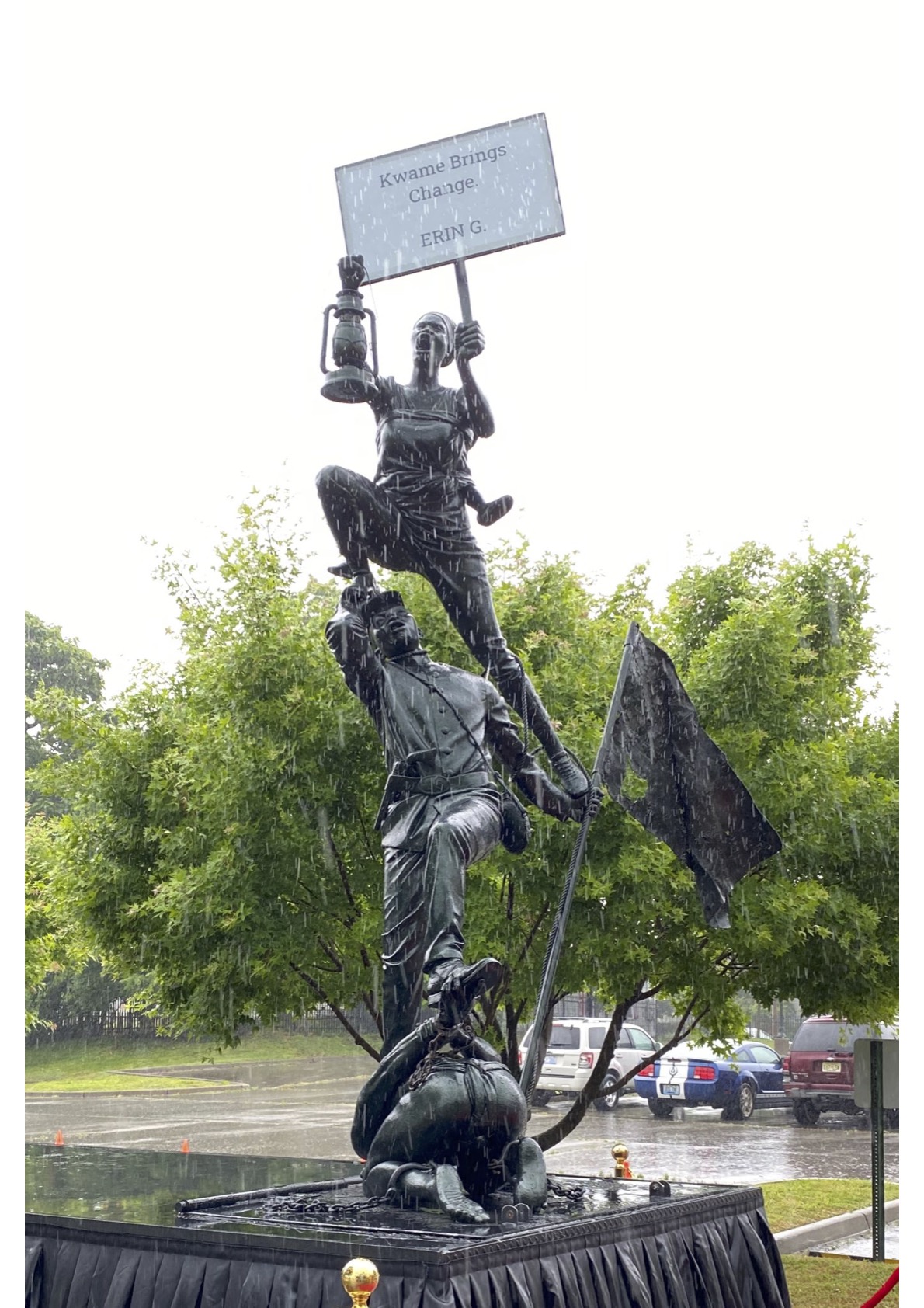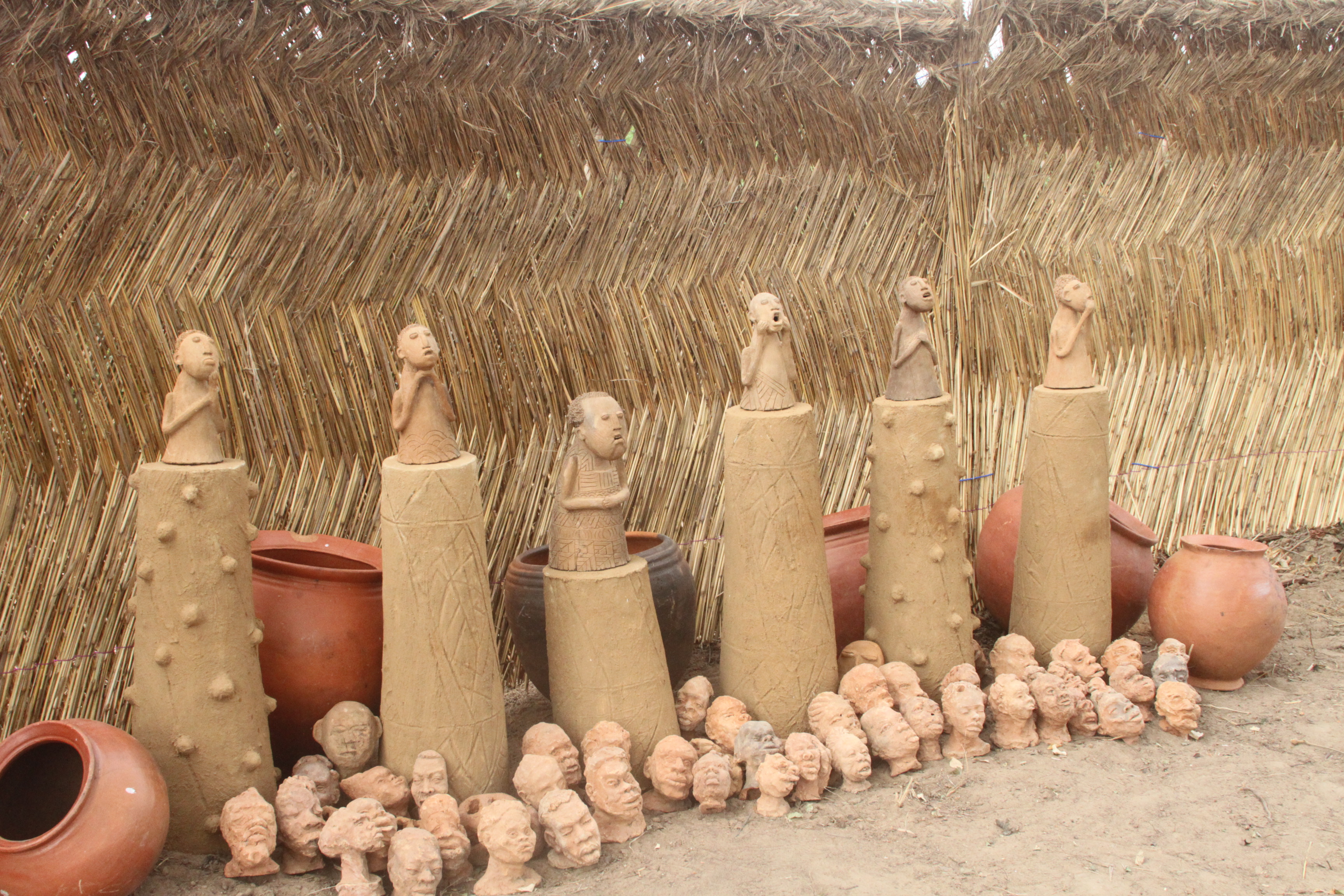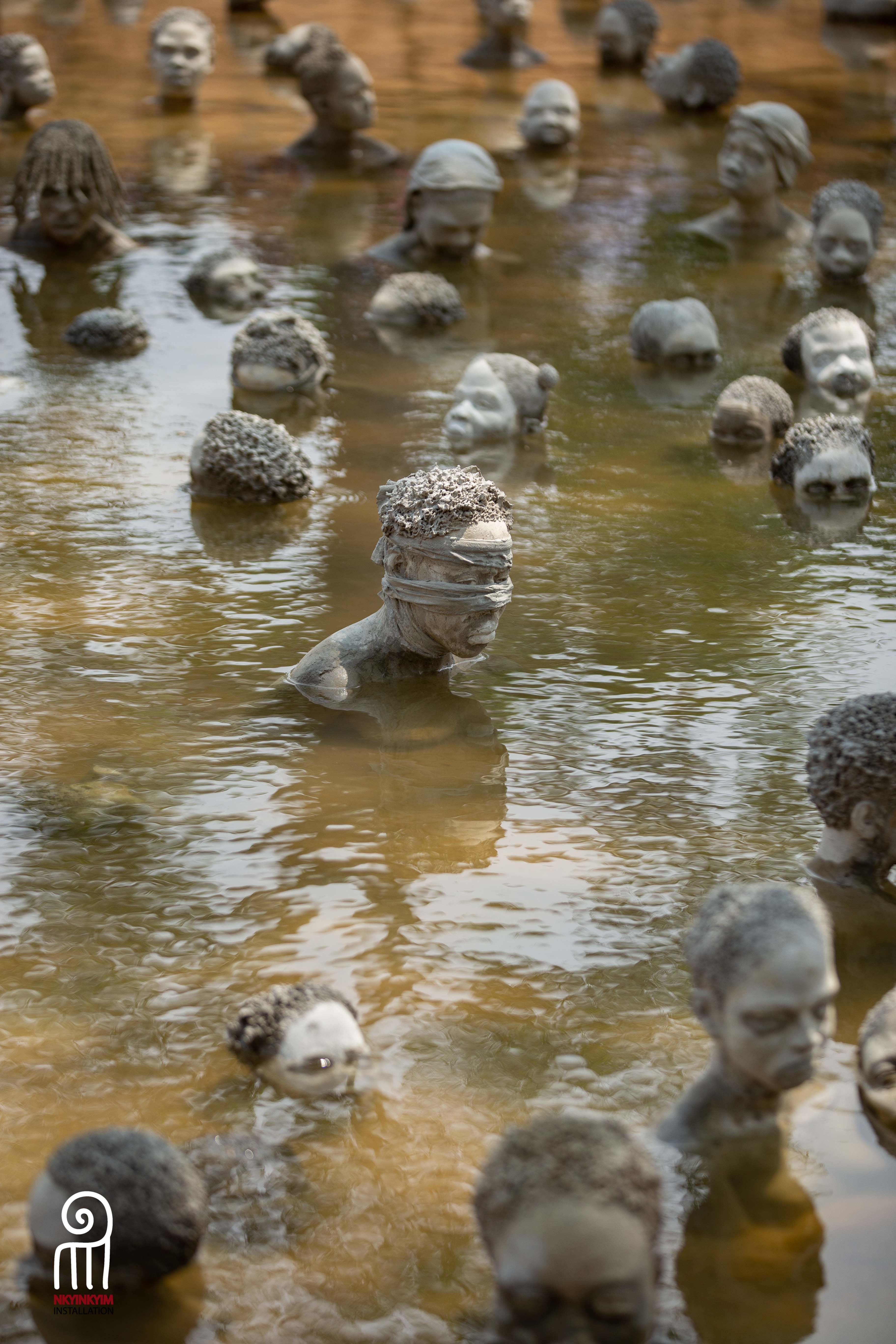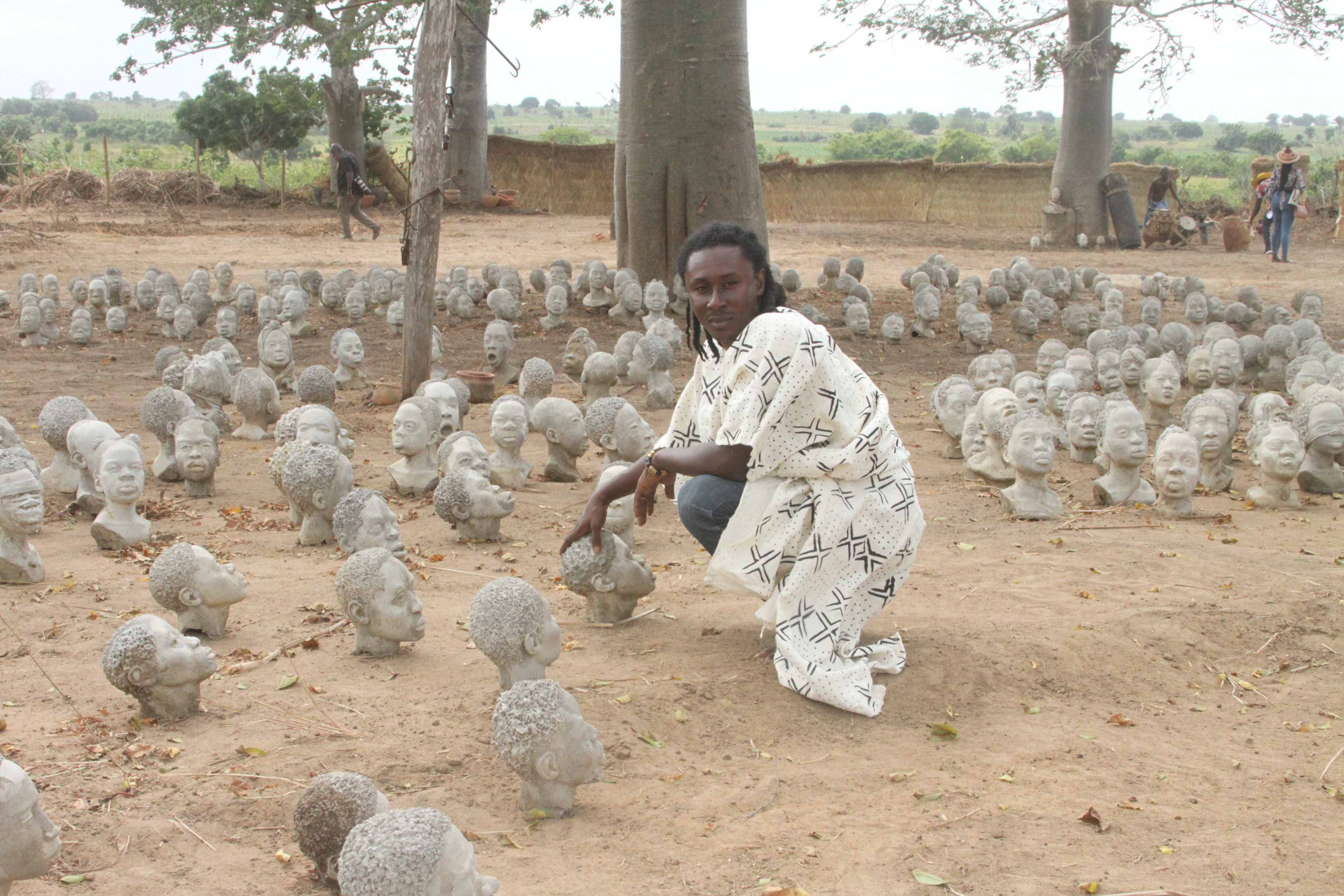Kwame Akoto-Bamfo is one of Ghana’s most currently celebrated artists in the international art world. This story is the result of several conversations that Rachel Ama Asaa Engmann had with the artist in 2021 that focused on the intersections of art, history, heritage, social and restorative justice.

Kwame Akoto-Bamfo is a Ghanaian artist. His latest sculpture, entitled Blank Slate: Hope for a New America, is a timely and apposite intervention in the ongoing discussions around the history and legacies of the transatlantic slave trade, slavery, and monuments. The statue depicts the intergenerational struggles in the African American experience: At its base, it depicts an enslaved ancestor, bent forward with his hands behind his back, head turned sideways, face on the ground, hands and feet bound in metal chains, and a booted foot on his head. It is a chilling reminder of an image with which we are only too familiar—though it must be noted that the sculpture was crafted prior to the death of George Floyd. On top of this figure is a union soldier with a noose around his neck. Finally, is the representation of an activist mother with baby, signifying the next generation. Akoto-Bamfo describes it as “a noisy one—a protest piece that speaks against racist civil war monuments.”
This mobile art installation is currently touring throughout the United States to several locations with a history and legacy of racial injustice, including Louisville, Detroit, Atlanta, Chicago, Selma, Birmingham, and New York. Akoto-Bamfo’s sculpture can be understood as a challenge to Confederate monuments and tribute to African American history and the ongoing fight for social and racial justice, as part of an attempt to heal the nation. He conducted extensive research for though he did not know where his work would be placed at the time that he was commissioned, he knew that Blank Slate would respond to monuments that his American “brothers have issues with.” Through this work, he strives to foster dialogue, provide a platform, and elevate the voices of those historically silenced and oppressed, by inviting the public to engage with the work through an interactive screen, where their words will be shared anonymously on the slate. This interactive sculpture invites communities to contribute, not only towards his artwork, but also to wider ongoing transnational conversations and initiatives around history, memory, justice, and monuments.
First unveiled during a private viewing in Ghana, prior to its shipment to the United States, many discussions transpired amongst those involved in the project: some feared it might incite violence, others said that it represented a prediction.

Akoto-Bamfo is no neophyte to the United States, and more particularly, to African diasporan audiences. Three years ago, he rose to international fame as a result of his installation and museum with the same name, Nkyinkyim (“twisting” in the Ghanaian Twi language, as in the proverb, “Life’s journey is twisted”). This work featured a compelling display of 1,500 concrete life size heads (the goal is to create 11,111) and 3,000 terracotta miniature sculpted heads, that represent captive Africans who were abducted, sold and forcibly trafficked during the transatlantic slave trade, and enslaved in the Americas. He captures captives’ shock, horror, anger, distress and fear—emotions communicated through their facial expressions in a large-scale installation that is disturbingly evocative and profoundly haunting. Inspired by ‘nsodie’, an Akan funerary tradition, Akoto-Bamfo’s work draws upon the Akan belief in commemoration and remembrance after death, “to honor the young, old, men and women, who originated from various ethnic groups, and who died in the Atlantic Ocean during the Middle Passage.”1 The heads are permanently exhibited at his museum but have also been displayed at Cape Coast Castle, one of the slave trading fortifications in Ghana.

Akoto-Bamfo’s work has a wide transatlantic following. One of his sculptures, an Nkyinkyim installation is also currently exhibited at the National Memorial for Peace and Justice and the Legacy Museum. One of his many talents lies in an impressive ability to engage through his work with transatlantic dialogues concerning the history and legacies of the transatlantic slave trade and slavery on both sides of the Atlantic, but from an African perspective. While he challenges the white supremacist notion that Africans were destined for slavery in the Americas, he also acknowledges the role of Africans in the transatlantic slave trade, indigenous slavery in Africa, and the legacies thereof.2 He notes, “Where we were wrong, we say it.”

As an African whose ancestors were not themselves enslaved, Akoto-Bamfo engages a diverse range of audiences and “tries do justice to various groups and locations.” He says, “I just want to use the little knowledge that I have to do something. All my work is based on humanity. Maybe I will move on from African enslavement, but it will always be in my work—until we get closure.” Engaging with projects in the African diaspora, Akoto-Bamfo states that “I have had the opportunity to work … without galleries telling me what I can and cannot do. If anything, my work is only going to be more and more offensive. It will only stop when people stop being offended by human rights”.

Akoto-Bamfo has always had an innate antipathy towards injustice, and he uses his art to express this aversion. He references the global Black Lives Matter movement, underscoring why artists do what they do. “My work is not only about the past, but what is unfolding now”. He sees this latest sculpture as part of his journey as an artist. “Many artists reflect the philosophies and ideas of the elite classes and not the common people, so I try to make sure that my work is relatable to the ordinary person.” Akoto-Bamfo adds, that as an artist, he “does not have the sole right to speak. With Blank Slate, I wanted ordinary Americans to add their voices, because I am already contributing. Therefore, my way is subtle – actually, less than subtle. As an African Pan-Africanist, I am not speaking as an authority on United States history, but as an authority on African humanity, as an authority on the African experience, equal rights and what it means to be human.”
